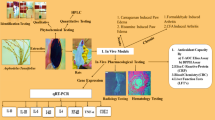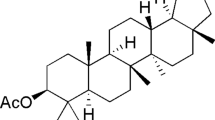Abstract
Inflammatory diseases being one of the back bending global burden are alarming the world. Established anti-inflammatory drugs exert side-effects, demanding for the development of alternative drugs, likely from natural source because of their diverse chemical nature. The anti-inflammatory activity of aerial part methanol extract of Elsholtzia densa collected from the natural forest of Naranag area of Kashmir valley was evaluated both in vitro and in vivo model systems using Macrophages RAW 264.7 cells and acute (carrageenan and histamine-induced rat paw edema) and chronic model (formaldehyde induced arthritis) respectively. The EDM extract exhibited a significant decline in the paw volume being at par with the standard drug Diclofenac (10 mg/kg) as compared with the control group. The reduction was observed in dose dependent manner with 300 mg/kg resulting in 27.27% and 100 mg/kg in 16.88% inhibition at 3rd h. A statistically significant (p < 0.05) decline in the secretion of serum pro-inflammatory cytokines like TNF-α, IL-1 β and IL-6 was found with 80.93%, 75.33% and 67.09%, and 83.25%, 62.11% and 66.69% in EDM-300 as compared with the carrageenan and histamine group respectively. The pro-inflammatory cytokines levels showed clampdown in LPS stimulated RAW264.7 by the extract treatments. The LC–MS data revealed the presence of Quercetin 3-glycosides, Apigenin 7-(2″-acetyl-6″-methylglucuronide) and betulinic acid as major compounds present in EDM extract. Results obtained from in vivo experiments demonstrate that oral administration of EDM extract significantly attenuated inflammation in carrageenan and histamine-induced paw edema, and improved chronic models (formaldehyde induced arthritis).





Similar content being viewed by others
References
Bagad AS, Joseph JA et al (2013) Comparative evaluation of anti-inflammatory activity of curcuminoids, turmerones, and aqueous extract of Curcuma longa. Adv Pharmacol Sci 2013:805756
Banerjee S, Sur TK et al (2000) Assessment of the anti-inflammatory effects of Swertia chirata in acute and chronic experimental models in male albino rats. Indian J Pharmacol 32(1):21–24
Bezaikovai L, Granacai D et al (2007) Effects of flavonoids and cynarine from Cynara cardunculus L., on lipoxygenase activity. Acta Facul Pharm Univ Com Tomus Liv 48-52
Botting R (2003) COX-1 and COX-3 inhibitors. Thromb Res 110(5):269–272
Chakraborthy GS, Singh V et al (2012) Antiinflammatory and antinociceptive activity of hydroalcoholic extract of Mirabilis jalapa and Mirabilis japonica. Orient Pharm Exp Med 12(3):177–180
Chandrasekharan NV, Dai H et al (2002) COX-3, a cyclooxygenase-1 variant inhibited by acetaminophen and other analgesic/antipyretic drugs: cloning, structure, and expression. Proc Natl Acad Sci 99(21):13926–13931
Choi J, Jung H-J et al (2005) Antinociceptive and anti-inflammatory effects of the saponin and sapogenins obtained from the stem of Akebia quinata. J Med Food 8(1):78–85
Chowdhury AR, Mandal S et al (2002) Betulinic acid, a potent inhibitor of eukaryotic topoisomerase I: identification of the inhibitory step, the major functional group responsible and development of more potent derivatives. Med Sci Monit 8(7):BR254–BR260
Cohen J (2002) The immunopathogenesis of sepsis. Nature 420(6917):885
Di Rosa M, Giroud JP et al (1971) Studies of the mediators of the acute inflammatory response induced in rats in different sites by carrageenan and turpentine. J Pathol 104(1):15–29
Ding C, Chen C et al (2004) Study on chemical constituent of essential oil from Tibetan medicine Elsholtzia ianthina. Acta Bot Boreal Occident Sin 24(10):1929–1931
Endale M, Park S-C et al (2013) Quercetin disrupts tyrosine-phosphorylated phosphatidylinositol 3-kinase and myeloid differentiation factor-88 association, and inhibits MAPK/AP-1 and IKK/NF-kB-induced inflammatory mediators production in RAW 264.7 cells. Immunobiology 218(12):1452–1467
Ferreroae Miliani L, Nielsen OH et al (2007) Chronic inflammation: importance of NOD2 and NALP3 in interleukin 1β generation. Clin Exp Immunol 147(2):227–235
Gardner DL (1960) The experimental production of arthritis: a review. Ann Rheum Dis 19(4):297
Gery I, Gershon RK et al (1972) Potentiation of the T-lymphocyte response to mitogens. J Exp Med 136(1):128–142
Ghosh B (1999) Quercetin inhibits LPS-induced nitric oxide and tumor necrosis factor-alpha production in murine macrophages. Int J Immunopharmacol 21(7):435–443
Goronzy JrJ, Weyand CM (2009) Developments in the scientific understanding of rheumatoid arthritis. Arthr Res Ther 11(5):249
Gratz G (2005) New insights into the molecular mechanism of interleukin-10-mediated immunosuppression. J Leukoc Biol 77(1):3–15
Holdsworth SR, Gan P-Y (2015) Cytokines: names and numbers you should care about. Clin J Am Soc Nephrol 10(12):2243–2254
Jingbo W, Aimin C et al (2015) Betulinic acid inhibits IL-1beta-induced inflammation by activating PPAR-gamma in human osteoarthritis chondrocytes. Int Immunopharmacol 29(2):687–692
Kim DW, Son KH et al (2003) Anti-inflammatory activity of Elsholtzia splendens. Arch Pharmacal Res 26(3):232
Lakhanpal P, Rai DK (2007) Quercetin: a versatile flavonoid. Internet J Med Update 2(2):22–37
Li C, Zhang C et al (2018) Inhibitory effects of betulinic acid on LPS-induced neuroinflammation involve M2 microglial polarization via CaMKKbeta-dependent AMPK activation. Front Mol Neurosci 11:98
Lingaraju MC, Pathak NN et al (2015) Betulinic acid attenuates lung injury by modulation of inflammatory cytokine response in experimentally-induced polymicrobial sepsis in mice. Cytokine 71(1):101–108
Liu A, Lee SMY et al (2007) Elsholtzia: review of traditional uses, chemistry and pharmacology. J Chin Pharm Sci 16(2):73
Manrique-Moreno M, Heinbockel L et al (2016) Biophysical study of the non-steroidal anti-inflammatory drugs (NSAID) ibuprofen, naproxen and diclofenac with phosphatidylserine bilayer membranes. Biochim et Biophys Acta Biomembr 1858(9):2123–2131
Meshram GG, Kumar A et al (2016) Evaluation of the anti-inflammatory activity of the aqueous and ethanolic extracts of the leaves of Albizzia lebbeck in rats. J Tradit Complement Med 6(2):172–175
Mueller M, Hobiger S et al (2010) Anti-inflammatory activity of extracts from fruits, herbs and spices. Food Chem 122(4):987–996
Nakamura H, Motoyoshi S et al (1988) Anti-inflammatory action of interleukin 1 through the pituitary-adrenal axis in rats. Eur J Pharmacol 151(1):67–73
Nathan C (2002) Points of control in inflammation. Nature 420(6917):846
Nijveldt RJ, Van Nood ELS et al (2001) Flavonoids: a review of probable mechanisms of action and potential applications. Am J Clin Nutr 74(4):418–425
Pinheiro RM, Calixto JB (2002) Effect of the selective COX-2 inhibitors, celecoxib and rofecoxib in rat acute models of inflammation. Inflamm Res 51(12):603–610
Porta H, Rocha-Sosa M (2002) Plant lipoxygenases. Physiological and molecular features. Plant Physiol 130(1):15–21
Sadik CD, Sies H et al (2003) Inhibition of 15-lipoxygenases by flavonoids: structure-activity relations and mode of action. Biochem Pharmacol 65(5):773–781
Sagnia B, Fedeli D et al (2014) Antioxidant and anti-inflammatory activities of extracts from Cassia alata, Eleusine indica, Eremomastax speciosa, Carica papaya and Polyscias fulva medicinal plants collected in Cameroon. PLoS ONE 9(8):e103999
Salvemini D, Wang ZQ et al (1996) Nitric oxide: a key mediator in the early and late phase of carrageenan-induced rat paw inflammation. Br J Pharmacol 118(4):829–838
Strzelecka M, Bzowska M et al (2005) Anti-inflammatory effects of extracts from some traditional Mediterranean diet plants. J Physiol Pharmacol 56(Suppl 1):139–156
Vane J, Botting R (1987) Inflammation and the mechanism of action of anti-inflammatory drugs. FASEB J 1(2):89–96
Vasanthi B, Komathi J et al (2012) Therapeutic effect of vitamin E in patients with primary osteoarthritis. Int J Recent Adv Pharm Res 2:46–50
Vinegar R, Schreiber W et al (1969) Biphasic development of carrageenin edema in rats. J Pharmacol Exp Ther 166(1):96–103
Wang Y, Lee SMY et al (2007) Elsholtzia: review of traditional uses, chemistry and pharmacology. 2007 (Refereed)
Zhang X, Wang G et al (2014) Flavonoid apigenin inhibits lipopolysaccharide-induced inflammatory response through multiple mechanisms in macrophages. PLoS ONE 9(9):e107072
Zhou X, Wang F et al (2017) Apigenin: a current review on its beneficial biological activities. J Food Biochem 41(4):e12376
Zimmer AR, Leonardi B et al (2012) Antioxidant and anti-inflammatory properties of Capsicum baccatum: from traditional use to scientific approach. J Ethnopharmacol 139(1):228–233
Acknowledgements
The author would like to acknowledge Department of Biochemistry (DST-FIST assisted), University of Kashmir and DBT-Ministry of Science and Technology, India for the financial support throughout the study.
Author information
Authors and Affiliations
Corresponding author
Ethics declarations
Ethical statement
All applicable international, national, and/or institutional guidelines for the care and use of animals were followed. All procedures performed in studies involving animals were in accordance with the ethical standards of the Animal Ethics Committee, University of Kashmir Srinagar (No.: F(IAEA-APPROVAL)KU/2015/10).
Conflict of interest
This manuscript described has not been published before; not under consideration for publication anywhere else; and has been approved by all co-authors.
Rights and permissions
About this article
Cite this article
Zargar, O.A., Bashir, R., Ganie, S.A. et al. The effect of Elsholtzia densa methanolic extract modulates inflammation in vitro and in vivo. Orient Pharm Exp Med 19, 49–58 (2019). https://doi.org/10.1007/s13596-018-0346-6
Received:
Accepted:
Published:
Issue Date:
DOI: https://doi.org/10.1007/s13596-018-0346-6




